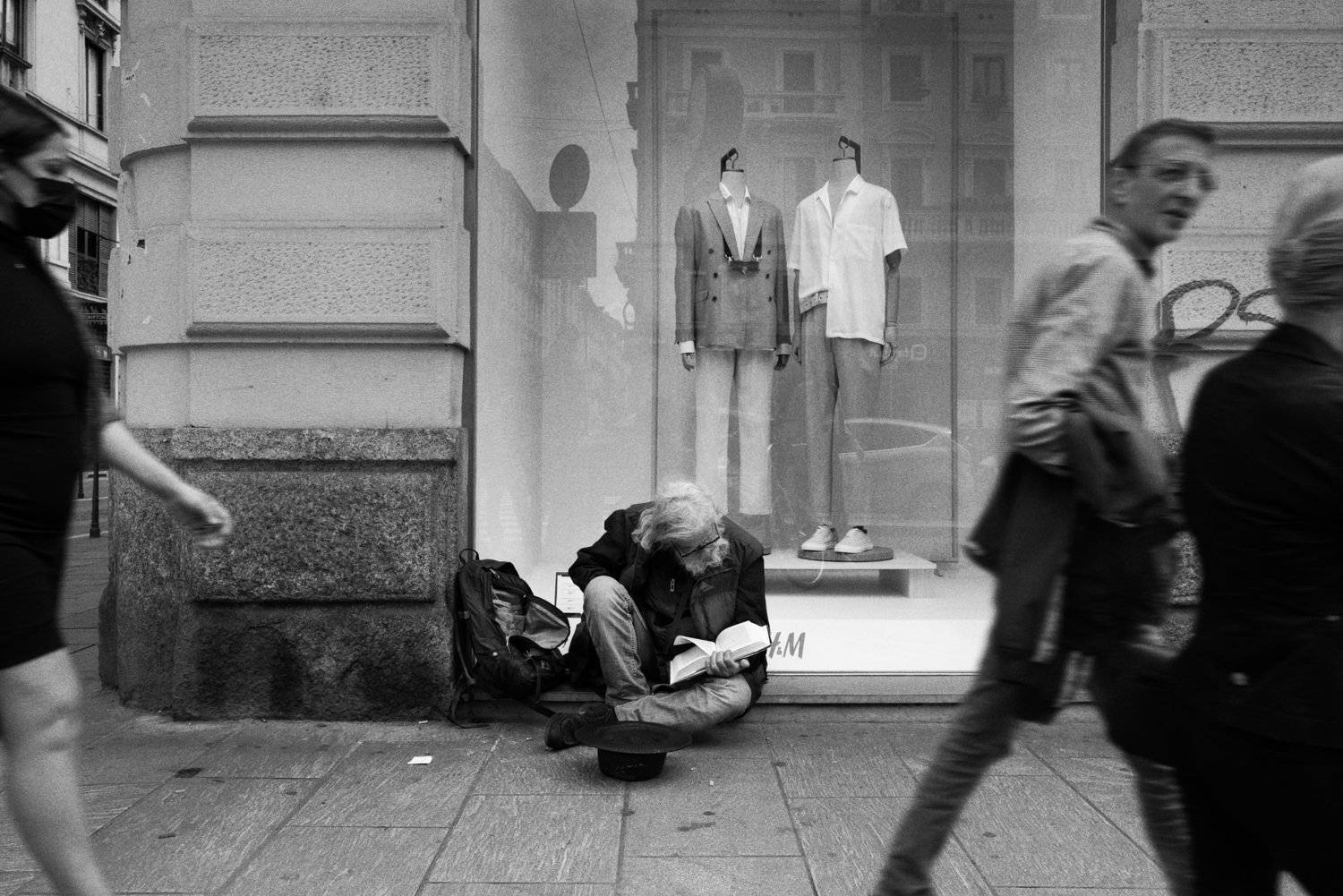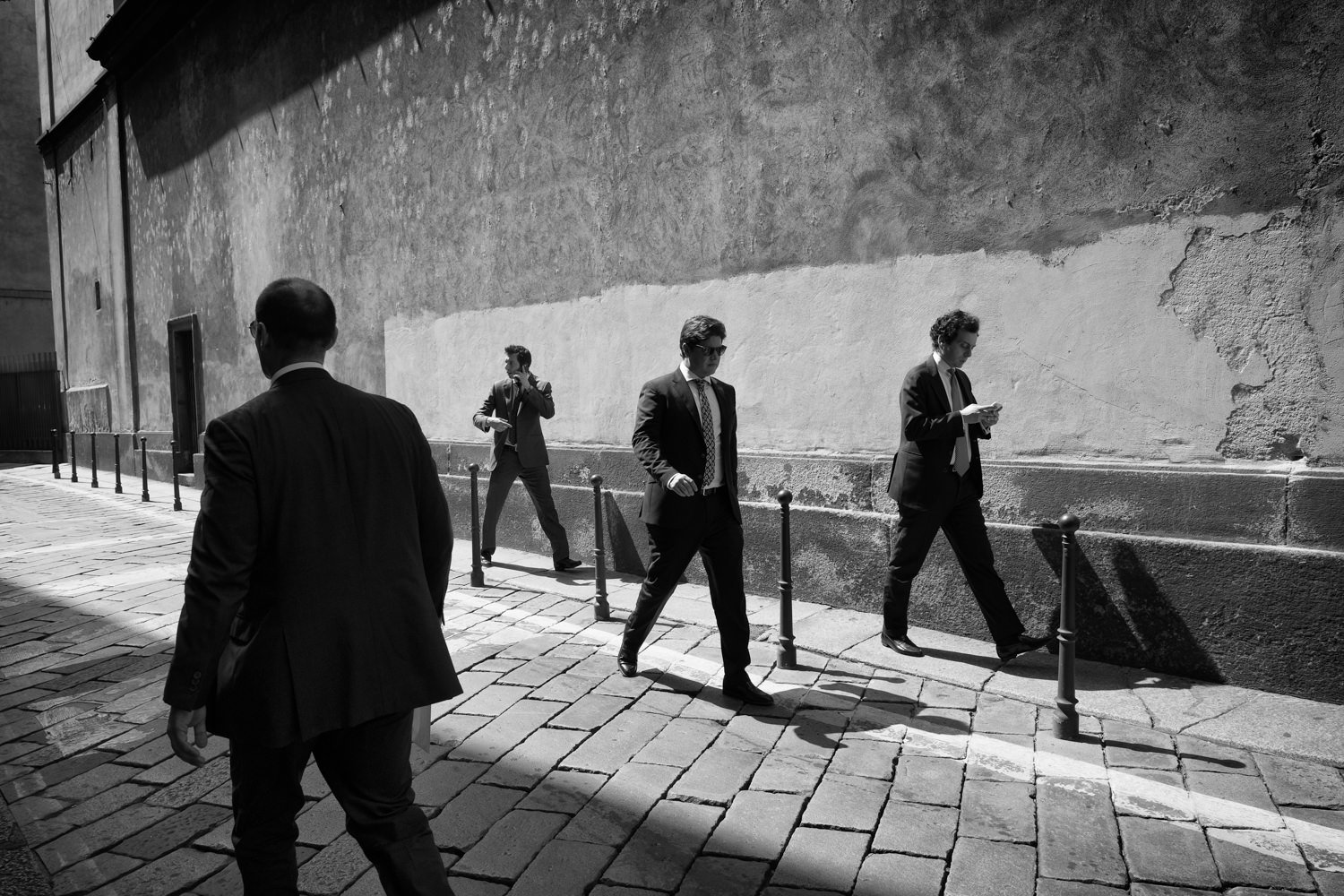Stepping into Milano is like entering a chiaroscuro painting, where centuries-old façades meet sleek modern lines under ever-shifting Italian light. This city—internationally revered for its fashion, design, and culinary traditions—unfolds with subtle layers, much like a well-exposed black-and-white negative. As I navigate its streets with my Leica Q—its 28mm lens perfectly suited to capturing both grand architectural scenes and intimate street moments—I find myself in constant dialogue with Milano’s dualities. The Q system’s responsive autofocus and discreet profile enable me to seamlessly shift from the bustling crowds of the Galleria Vittorio Emanuele II to the hushed solitude of a hidden cortile, ensuring that nothing disrupts the quiet poetry of these cityscapes.
My personal bond with Milano stretches back to my first visit as a student of photography, eager to discover how modernity coexists with heritage. Surrounded by gothic spires, Renaissance masterpieces, and contemporary sculptures, I learned quickly that this city can’t be distilled into a single narrative. Instead, it’s a tapestry of contrasting stories: elegant avenues and gritty side streets, Michelin-starred restaurants and neighborhood trattorie, the hush of ancient churches and the hum of cutting-edge fashion ateliers. Shooting in monochrome strips away the distraction of color, leaving me with the stark interplay of light and shadow that reveals the city’s emotional core.
The allure of Milano isn’t just visual; it’s a feeling that deepens with every return. Twice a year, I have the pleasure of hosting intimate workshops here—immersive experiences where fellow photographers join me in exploring the city’s soul. The Leica Q’s built-in stabilization and intuitive controls make it an ideal companion in these sessions, allowing participants to focus on composition, timing, and narrative. Whether we’re strolling along the Navigli canals at dusk or capturing the theater of everyday life in Piazza del Duomo, my goal is to help others discover their unique perspective on Milano’s complexity.
Milanesi, as the locals are known, carry themselves with a particular grace and purpose. They navigate the city as if composing a personal soundtrack—head bowed over an espresso bar or moving briskly between a boutique and a gallery. Observing them reveals a lesson in subtlety and restraint. Their body language, manner of dress, and way of engaging with space reflect a culture that values discretion over display. In the ebb and flow of commuters, shopkeepers, students, and tourists, I find countless narratives that play out quietly in front of my lens.
On my earliest visits to Milano, I was drawn to the contrasts that now define my photography. Standing outside the Duomo’s majestic marble facade, I marveled at the interplay of old and new. Over time, I’ve come to see this tension as a vibrant source of creative energy. Capturing Milano as a Gaijin—an outsider, just as I did in Tokyo—reminds me that the city doesn’t unfold its secrets all at once. Every photograph offers a glimpse into a different layer, whether it’s the reflection of modern skyscrapers in a vintage tram window or the worn textures of a cobblestone street beneath the latest streetwear fashions.
Milano’s residents have a remarkable ability to find personal space within the urban density. In a bustling café or a crowded piazza, a Milanese might pause, linger over a cappuccino, or check directions on their phone, carving out a brief moment of solitude in a city of 1.3 million souls. This interplay between communal life and individual privacy creates a visual rhythm—pockets of stillness amid the flow of commerce and conversation.
Through my Leica Q, I strive to capture these quiet interludes. The silence here isn’t empty; it’s charged with subtle emotion. Each monochromatic frame stands alone, a self-contained story with its own cadence and tone. Yet when I look at them collectively, they form an intricate mosaic of Milano’s many dimensions—its elegance and its grit, its grandeur and its intimacy—elevating the everyday into something timeless.
25 Locations for Black-and-White Street Photography in Milano:
Piazza del Duomo & Duomo di Milano:
The city’s heart and a Gothic masterpiece. Shoot upward to accentuate the cathedral’s spires or frame commuters passing in front for iconic silhouettes that highlight Milano’s storied heritage.Galleria Vittorio Emanuele II:
A temple of commerce with a glass-and-iron canopy. The interplay of light on its mosaic floors and the echo of footsteps provide dramatic contrasts worthy of black-and-white.Teatro alla Scala & Surrounding Streets:
Outside this world-famous opera house, well-dressed patrons and curious tourists create refined street scenes. Look for gestures and glances that convey the city’s love of arts and elegance.Brera District:
Narrow cobblestone lanes, art galleries, and academic halls. Brera’s old-world charm and intellectual vibe invite you to find quiet corners where artists, students, and gallery-goers cross paths.Navigli Canals:
The flowing water, iron bridges, and lively cafés along the Navigli exude romance. At dusk, the interplay of lamplight and reflection can render timeless images that channel the spirit of old Milano.Porta Nuova & Piazza Gae Aulenti:
Modern skyscrapers, gleaming façades, and urban installations contrast strikingly with the city’s historic core. Black-and-white emphasizes shape and form in this contemporary quarter.Corso Vittorio Emanuele II & San Babila:
A major shopping avenue where fashion-conscious Milanesi stroll purposefully. The hustle of luxury boutiques and street vendors set against old façades creates layered compositions.Via della Spiga & Quadrilatero della Moda:
The fashion district’s polished storefronts and stylish patrons make for elegant street portraits. Catch reflections in glossy windows to contrast traditional architecture with cutting-edge design.Castello Sforzesco & Parco Sempione:
A Renaissance fortress and a sprawling park offer respite from the urban pace. Children playing, couples strolling, and street musicians against centuries-old walls yield contemplative scenes.Cimitero Monumentale:
An open-air museum of sculpture and memory. Black-and-white photography enhances the poetic stillness and the interplay of light on marble tombs and intricate statuary.Porta Ticinese & Colonne di San Lorenzo:
Roman ruins and medieval gates merge with youthful nightlife. Street artists, skateboarders, and late-night diners converge here, creating dynamic scenes of cultural exchange.Chinatown (Via Paolo Sarpi):
A multicultural hub offering diverse street life. The interplay of signs, markets, and local characters weaves a tapestry of global influences that stand out vividly in monochrome.Isola District & Bosco Verticale:
Trendy cafés, street art, and the iconic “Vertical Forest” towers define this evolving neighborhood. Focus on lines and textures where greenery meets contemporary design.Stazione Centrale:
Milano’s grand central station, a stage for arrivals and departures. Dramatic shafts of light, architectural geometry, and travelers in motion create narratives of longing and return.University of Milano (Statale) & Surroundings:
Academic quads, cloisters, and young scholars in discussion. The interplay of old lecture halls and new ideas provides a subtle contrast, perfect for black-and-white storytelling.Via Torino & Ticinese District:
A mix of old churches, alternative shops, and street vendors. Seek out lively street corners, where fashionistas, tourists, and locals weave a vibrant urban tapestry.Piazza Affari & The ‘L.O.V.E.’ Sculpture by Cattelan:
The financial district’s rigid lines and business attire gain intrigue with Maurizio Cattelan’s irreverent sculpture. Black-and-white emphasizes the tension between commerce and critique.Via Dante & Cordusio:
A pedestrianized street connecting the Duomo and the Castello. The flow of people, elegant signage, and subtle architectural details offer a rich vein for candid portraits.Fondazione Prada & Surrounding Industrial Areas:
Contemporary art spaces set amid repurposed industrial structures. Stark contrasts between minimalist design and raw textures create an avant-garde playground for your lens.Piazza XXIV Maggio & Darsena:
A riverside basin once crucial to Milan’s trade, now a lively leisure hub. The reflections of people along the water’s edge take on a painterly quality in black and white.Via Montenapoleone:
High fashion and understated luxury define this famed street. Tight framing on accessories, gestures, and glances can capture the essence of Milanese elegance in silent moments.Chiesa di Santa Maria delle Grazie & The Last Supper Vicinity:
Pilgrims, tourists, and art lovers gather near Leonardo’s masterpiece. Black-and-white’s timeless quality can parallel the enduring impact of Renaissance genius.Mercato Metropolitano & Street Markets (e.g. Papiniano):
Bustling food markets, vibrant produce stands, and everyday exchanges. Shooting in monochrome sharpens focus on expressions, textures, and the choreography of vendors and buyers.Arco della Pace & Parco Sempione Edges:
Neoclassical arches and leafy avenues set the stage for peaceful street photography. Cyclists, dog walkers, and picnickers create vignettes of Milanese leisure.Lorenteggio & Outlying Neighborhoods:
Venture beyond the historic center into residential districts. Ordinary life unfolds here—children at play, neighbors chatting—providing authentic glimpses of Milan’s soul, far from the tourist’s lens.
Each neighborhood in Milano contributes a distinct note to the city’s subtle symphony. By navigating these varied locales with your street photography camera, you’ll find that the absence of color reveals a deeper truth: the interplay of light and form, the nuance of gestures, and the quiet stories that define everyday existence. Milano’s beauty resides in these contrasts and continuities—a city where the ancient and the contemporary share the stage, each sharpened by the timeless honesty of monochrome photography.
Visit my Milano Street Photography Portfolio






